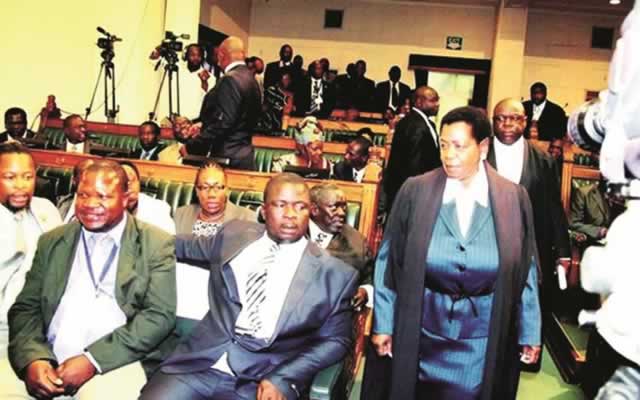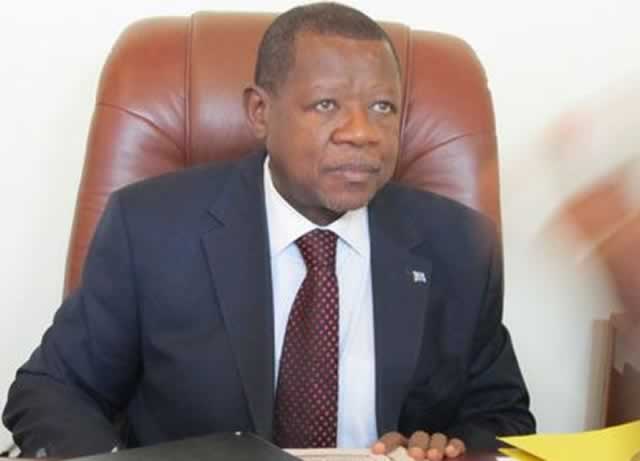Key milestones in Zim’s Legislature


The history of the Zimbabwean Senate dates back to the 1924 Rhodesian Constitution that provided for the establishment of an Upper House. Cde Edna Madzongwe i(right) is the current President of the Senate
Political Writer
ZIMBABWE became a republic on April 18 1980 with a bicameral system of government. Bicameralism is the practice of having two parliamentary chambers, an Upper House – the Senate, and a Lower House, the House of Assembly.
The Upper House was made up of senior politicians who had played a less combative role in the liberation struggle.
It provided the much-needed moderation over the democratisation aggressiveness of the House of Assembly that was dominated by politicians who had been scathed by enemy fire on the frontline.
Most of the Senators – barring four ex-detainees, two advisors to the nationalist parties and one who had been a nationalist representative in the West – were distinguished academics or technocrats who were renowned for their service in international institutions.
Their expertise was thus invaluable to the young legislature.
The two chambers also accommodated the dual structure of the State that had been entrenched by years of colonial misrule that produced the European-African divide. The bicameral system enabled simultaneous representation of the popular national interests, as well as State and regional interests of the country’s three major nationalities – the Shona speaking, Ndebele speaking people and the white minority groups, all of whom were well represented in both Houses.
This was crucial to the maintenance of post-independence stability.
The Lower House, on the other hand, consisted of the younger aggressive politicians, who were still learning the ropes, and this is where the experience of the older technocrats in the upper chamber came in handy. The first Speaker of the House of Assembly was Cde Didymus Mutasa.
The history of the Zimbabwean Senate did not begin in 1980, as it can be traced back to the 1924 Rhodesian Constitution that provided for the establishment of an Upper House. It, however, only came into existence under the 1969 Constitution after the settler regime felt the need to bring chiefs into Parliament in an attempt to stem the rising nationalist sentiment.
The Constitution of Zimbabwe provided for a two-chamber Parliament: a Senate consisting of 40 members; 14 of whom were elected by an Electoral College made up of the 80 members of the House of Assembly elected on the black roll. Ten who were chiefs – five from Matabeleland and five from Mashonaland. The President appointed the other six members after consulting the Prime Minister.
Ten of the 40 Senate seats were reserved for whites. This meant that the Republican Front (RF) which represented less than 1 percent of the population had an enormous 25 percent representation in the Upper House.
Cde Chipo Nolan Makombe was the president, with Cde Joseph Culverwell as the Leader of the Senate.
The Senate was made up of distinguished Zimbabweans who had outstanding international reputation. Among them were Dr Bernard Chidzero, who had served on various bodies of the United Nations and Dr Simbi Mubako, a legal expert, who became the country’s first Minister of Justice and Constitutional Affairs.
The House of Assembly had 100 members who were elected directly by the electorate from two rolls; the 80-seat African roll and the 20-seat White roll.
Of the 80 black roll seats, the ruling Zanu-PF party had 57 Members of Parliament (MPs), PF-Zapu had 20 and the United African National Council (UANC) of Abel Muzorewa had three seats.
The RF dominated the white roll with 20 seats. This racial profiling of Parliament that was enshrined in the Lancaster House constitution as a way of protecting minority privileges expired in 1987, paving the way for the implementation of 12 legislative changes that included the creation of a single-chamber legislature and executive presidency.
These changes were effected by the passage of the Constitution of Zimbabwe Amendment (No. 6) Bill in the House of Assembly on August 21, 1987 with a margin of 78 to zero. The Bill abolished both the 20 uncontested white-roll seats and the 10 reserved Senate seats. These became the 30 non-constituency seats. All the voters on the white roll were put on the Common Roll.
This, however, signalled the end of the white community’s participation in Zimbabwean politics even though no one had or has been barred from contesting in any poll on racial, religious or whatever grounds in the history of our democracy.
The white community lay low till the year 2000 when their interests were threatened by two landmark developments: the Constitutional Commission’s Draft Constitution and the agrarian reform programme it espoused in its clauses.
The white electorate turned out en masse to mobilise against both developments during the Constitutional Referendum in February and the general election in June.
The other major transformation to the legislature occurred in November 1989 with the passage of the Constitution of Zimbabwe Amendment (No. 9) Bill with a majority of 70 to one.
The Bill combined the Assembly and the Senate into one chamber of 150 members: 120 constituency MPs were elected through universal adult suffrage, eight (now 10) are provincial governors appointed by the President while the remaining 12 are non-constituency MPs who were also appointed by the President. The remaining 10 seats are reserved for chiefs who are appointed by the Chiefs Council, one from each province.
The Government considered re-introducing the Senate prior to the 2000 general election as the Draft Constitution proposed a 60-member Senate. Each of the country’s 10 provinces was to elect five Senators by secret ballot in terms of the Electoral Act.
The remaining 10 slots were to be filled by elected chiefs, one from each province.
The new Constitution also provided for a 200-member National Assembly.
Though the Draft Constitution was ignorantly rejected by the opposition, many of whom are now clamouring for the clauses that were enshrined therein, the Senate was re-introduced in 2005, marking yet another landmark development in the country’s legislature, and a reversion to the two-chamber model that was dropped after the first decade of independence.
Several innovations have been made to make our representative democracy relevant to the people.
The major developments have been the introduction of well-equipped Constituency Information Centres in all the country’s constituencies.
These have enabled constituents to interact with their MPs and get valuable information concerning the business of the House.
The record of proceedings in the House – the Hansard – is also available at the centres free of charge.
A Parliamentary Reform Programme was launched in 1997 which ushered in a more responsive Parliament for the new millennium.
The reforms which are now being implemented focus on making Parliament more responsive to the public, more effective in calling the Government to account and more efficient in the way it goes about its business.
It has been recognised that the time afforded during plenary sessions is inadequate.
It is in this context that Parliament formed parliamentary committees which play a vital role in the monitoring of public policy programmes and expenditure and by advocating transparency and accountability.
These committees have enabled Parliament to exercise a more efficient oversight role hence the parliamentary reform exercise reviewed and restructured committees to make them proactive and open to the public.
These committees replaced the old four departmental select committees that were in place in earlier parliaments, to ensure more regular and thorough shadowing of the activities of all ministries, Government departments and paras- tatals.
They have powers to conduct public hearings on legislation, policy objectives and the administration of ministries and departments.
The new system will allow a closer scrutiny of each ministry, and enable greater cohesion between the legislature and the executive.
In spite of these developments, the issue of female representation has remained a major weakness of our legislature. The Government has, however, made strides towards improving this anomaly in line with the Southern African Development Community (SADC) Protocol on Gender that seeks to have at least a 30percent female representation in Parliament.
The new Constitution adopted in 2013 further cements Zimbabwe’s legislature and in particular female representation.
The new Constitution’s provisions on gender equality align with several of key international and regional gender equality and women’s rights instruments that Zimbabwe has signed and ratified.
These include the Protocol to the African Charter on Human and People’s Rights on the Rights of Women in Africa and the Southern African Development Community Gender and Development Protocol, among others.
The Constitution opens with provisions stating that respect for gender equality is one of the country’s founding values.
The Declaration of Rights which includes a section on women’s rights, has been expanded to include socio-economic and cultural rights, and it can be used in legal or judicial proceedings.
This means new opportunities for women in jobs, education, finance and credit must be ensured by the government and in national funding.
The new Constitution also includes a special measure to increase women’s representation in Parliament. In the National Assembly, 60 reserved seats for women will be elected through a system of proportional representation based on the votes cast for political party candidates in a general election for the 210 members.
The 60 reserved seats for women will be additional to any women elected to the other 210 seats.










Comments